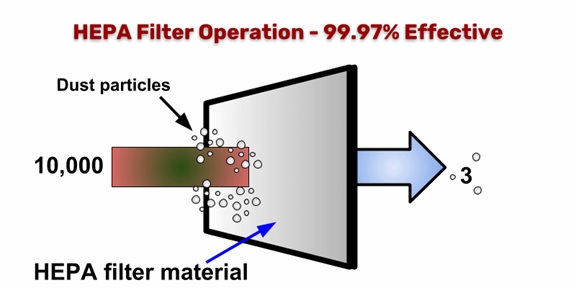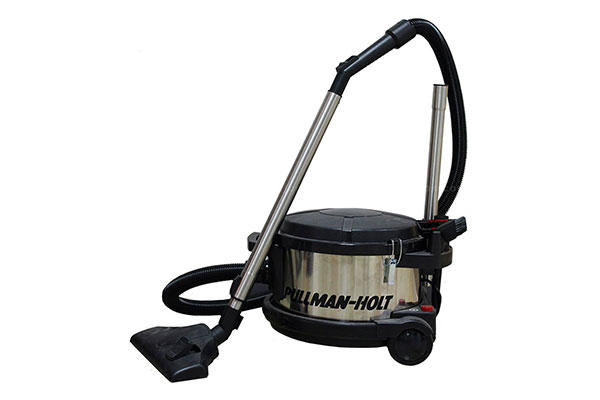What is HEPA and what does it mean? Let’s answer the second part of the question first. HEPA stands for High Efficiency Particulate Air. There you go, that explains it all, doesn’t it? Well, maybe not quite. A HEPA-filtered vacuum will capture 99.97% of all contaminate particles that are at least 0.3 microns in size (a human hair averages 50 microns).

On average, only 3 particles out of 10,000 may pass through a HEPA filter.
On a historical note
HEPA standards and filters were first developed in the 1940’s by the United States Department of Energy for use in nuclear facilities. They were designed to filter radioactive particles during work on the Manhattan Project. HEPA technology was kept classified until shortly after the end of World War II.
What a HEPA Vacuum Does
All mold spores are larger than 0.3 microns. Smaller particles can pass through a HEPA filter, these smaller particles include some viruses and bacteria as well as the mycotoxins produced by molds. So never assume that by using HEPA filtration that you are safe from anything that may be bad for your health.
Every vacuum used in the restoration industry should be a HEPA one, even when just vacuuming before or after a carpet cleaning job. The public should be made aware of items listed as “HEPA-like”. HEPA-like is not true HEPA. These vacuums should not be mistaken for true HEPA filtering vacuums. And never mistake “efficiency” with “effectiveness”. These are two different measurements. When dealing with vacuums the word “efficiency” describes a percentage, in the case of HEPA, 99.97%. “Effective” just describes how well a vacuum cleans.
The first public usage of HEPA vacuums and filters were by hospitals, pharmaceutical labs, aerospace engineering labs, and computer chip manufacturing plants. Today, because of their recognized value, HEAP vacuums and filters are being used in several other industries and by many homeowners, especially those that have a family member that suffers from asthma and have other allergic reactions related to the air they breathe. Even if no one in your immediate family suffers from any of these types of health conditions you should make use of HEPA vacuums and filters in your home.
6 HEPA Vacuum Requirements
- Sealed Chassis – no air leaks, especially around interior gaskets.
- No Odors or Smells – if there are smells, there is an air leak somewhere.
- A Pre-Filter – HEPA filters are expense to replace and should always be “protected “ by one or more pre-filters.
- Versatility – they should work on all types of surfaces and contaminants.
- Certification – they should have a seal of approval from the Asthma and Allergy Foundation of America (AAFA).
HEPA Vacuuming as the Final Step
At the start of every mold remediation project (also include sewage cleanups, asbestos abatements, and crime scene cleanups) HEPA vacuuming should be done to eliminate as many contaminants at the beginning as possible
Mold removal is down in stages, (usually a minimum of three times over three 24 hour periods) with time allocated for contaminants to re-settle on surfaces. Many mold remediations include cutting out of drywall or other structural materials. As mold grows, it secretes mycotoxins onto the surfaces on which it grows. No matter what type of saw or cutting device is used, contaminant particles, some possibly containing mycotoxins, will be disbursed into the air.
Damp wiping followed up by HEPA vacuuming is the best way to capture any contaminants previously missed at the prior stage. The final step of any job like this should be one more pass through the entire area with a HEPA vacuum, BEFORE shutting down any air scrubbers.
Does It Leak?
In order to make sure a HEPA vacuum is doing as it should, it should be thoroughly cleaned at the end of every job, the canister cleaned inside and out, and if it uses a vacuum bag, the bag should be properly disposed of. On a regular schedule the vacuum should be tested to ensure that it is sealed properly and has no air leaks that could release particles back into the air. The best way to do this is with a handheld laser particle counter.
Water Mold Fire Restoration uses true HEPA vacuums and filters. Our technicians are trained in the set up and use of HEPA filtration machines and understand their importance on a jobsite. We can handle every kind of water, mold, or fire emergency and we answer our phones with a live person 24/7. Call us for a free, no-obligation consultation at 800-905-0277. If telephoning isn’t convenient, email us at help@watermoldfire.net. No emergency is ever too large or too small for our emergency response teams to address.








